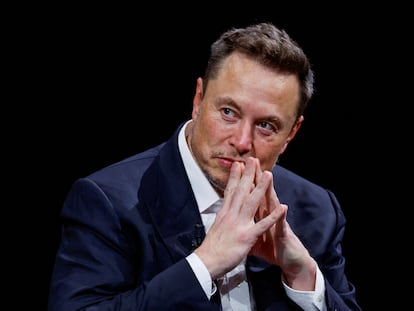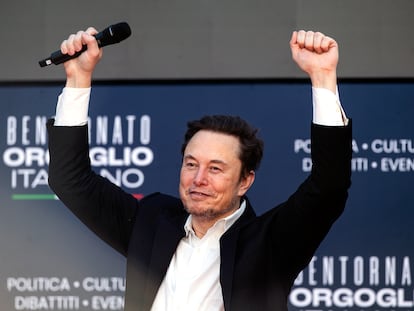‘We have consistently flirted with death’: The construction problems in Elon Musk’s tunnels
The Loop, the modular network of underground connections aimed at ending traffic jams in cities like Las Vegas or Los Angeles, has sparked controversy after several workers denounced the precarious conditions of the digging work
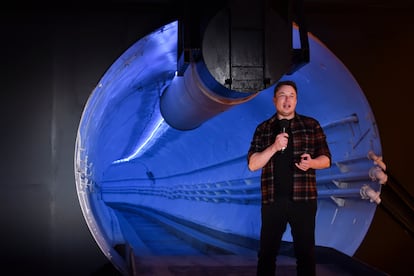
It all started with a tweet. In the fall of 2016, now seven and a half years ago, Elon Musk took to Twitter to tell the world that he was fed up with the traffic in Los Angeles and that he had decided to remedy it. His solution, as prosaic as it was effective, consisted of building tunnels and taking a large part of that traffic underground, to a high-performance network where people could get from any point in the center of the big city to airport terminals in less than 10 minutes — all for just a $1 one-way ticket.
To materialize this utopia of urban mobility in record time, Musk created the Boring Company, his first major infrastructure company, presented with the appropriate pomp and ceremony in Hawthorne, California, in December 2016. Shortly after, Boring announced the launch of The Loop, a “modular” network of underground connections that was going to begin construction in less than a year in four metropolitan areas: Chicago, Los Angeles, Las Vegas and the conurbation between Washington D.C. and Baltimore.
The company’s initial steps — the construction of a first tunnel in Hawthorne, a test bed for Musk’s team innovative technology — suggested that the Californian phase was going to be a priority. But in the end, it was the Las Vegas Loop that became the Boring Company’s star project. It was an ambitious project, with an initial budget of $48.7 million that was set to rise to more than $500 million once it had passed the early phases. By 2024, the network was expected to cover nearly 70 miles and include 55 stations. A fleet of Tesla Model 3 cars, mostly self-driving, was going to cover the routes at an average speed of 150 miles per hour.
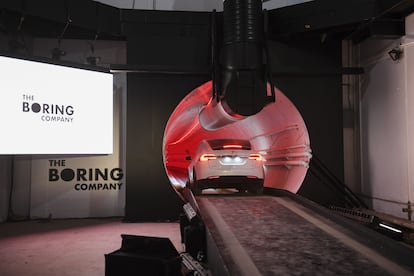
Problems arise
In recent weeks, media outlets such as Fortune, Bloomberg, Fox and QZ have reported on an incident that occurred several months ago, but has only just become public. As Jessica Mathews explains in Fortune, in May 2023, the then safety manager of one of the Boring Company’s branches, Wayne Merideth, sent a late-night email to his superiors in which he denounced the precarious conditions of the Las Vegas tunnel excavation works.
Merideth wrote that the company “has been very fortunate these past few months that there hasn’t been a fatality.” The safety manager said the lack of supervision and basic precautions had made the underground work highly dangerous. “We have consistently flirted with death,” he said in the email.
Merideth blamed the dire safety conditions on the company’s poorly calibrated attempt to accelerate the pace of excavations to meet deadlines that were never realistic and, what’s more, did not take into account the particularities of the terrain. Bloomberg journalist Max Chafkin reported that the excavation team has been forced to deal with pools of mud at least two feet deep with the “consistency of a milkshake” and a high degree of toxicity. Several employees said they had suffered burns, rashes and allergic reactions attributable to the high concentration of chemical accelerants (the byproducts of any dig) in the mud. Some of these injuries had become chronic due to the workers’ continuous exposure to the accelerants, an issue the company did not try to address. Merideth ended his email with this cutting sentence: “No tunnel is worth a single person’s life.”
Bloomberg reported that the workers’ complaints have reached the Nevada state health and safety commission. The newly opened proceedings could lead to million-dollar penalties for the Boring Company and cause new delays in the construction of the underground network that was going to transform the Las Vegas metropolitan area.
What’s happening in Las Vegas
The first two sections of the Vegas Loop — drilled 12 meters deep — were built in the spring of 2020 and entered the testing phase a year later, once the last of the Covid-19 restrictions were lifted. Tens of thousands of volunteers were willing to act as guinea pigs on wheels in the cutting-edge experiment.
A few weeks later, Boring announced that these two sections and the five stations already operational had demonstrated their capacity to transport nearly 4,400 passengers per hour, with most journeys lasting less than five minutes. The launch and debut of the Vegas Loop would come a year and a half later, coinciding with the 2023 edition of the Consumer Electronic Show (CES).
At that time, Adrián Revuelta, a 43-year-old engineer from Madrid, who was a resident in Las Vegas and accredited at the 2023 fair, had the opportunity to go underground to see what Elon Musk’s new avant-garde development had to offer. “I remember that it seemed like an extravagance without much substance, far below initial expectations,” he told EL PAÍS. “I went down some escalators that gave access to a kind of quite precarious subway platform. Once there, after a short wait, they boarded me with another couple of travelers into a white Tesla Model Y piloted by a company driver. In a few minutes, at a constant speed of about 60 kilometers [40 miles], we traveled the only section available that day, around four kilometers [2.5 miles] between one end of the convention center and the other.”
The driver, apparently repeating the arguments that the company had given him, told Revuelta that this was the first “of more than a hundred tunnels that were going to be available in a few months and that very soon would take in between 5 and 10% of the private traffic of the city of Las Vegas.” Revuelta showed his skepticism and even commented that the tunnel — measuring “just three and a half meters wide, illuminated with rather dim LED lights” — seemed a bit “claustrophobic.” The driver shrugged his shoulders and acknowledged that there were still “minor details” to iron out. He then spoke to him about the magnificent opportunity that this cutting-edge engineering work was going to provide for professional drivers like him. “He imagined a fleet of thousands of electric cars making continuous journeys from one end of the network to the other. I asked him if there were plans to replace them with self-driving vehicles in the very short term and he replied that this idea had been rejected for safety reasons.”
Once on the surface, Revuelta met a co-worker who had also gone down to Musk’s underground tunnel and was as wary as him about the project. “He told me that it seemed like a cross between a private limousine service and the reinvention of the subway. We agreed that, no matter how much they promised individual routes for $1 and daily passes for less than $5, it seemed to be conceived rather as a very restricted and elitist network, a minority solution so that the richest could avoid the inconvenience of traveling on the surface. It seemed to us then and it still seems to me now that its impact on city traffic is going to be very limited. I think it is very unlikely that a network with these characteristics will one day absorb between a twentieth and a tenth of the vehicles that circulate through the city.”
Revuelta lives very close to the southern end of the Strip, the most popular “and most congested” avenue in Las Vegas. Few people would benefit more from Musk’s umpteenth idea becoming a success. What’s more, Revuelta is willing to recognize “its indisputable potential” and give it the benefit of the doubt. But he says nothing he has seen or read has inspired “even moderate” optimism.
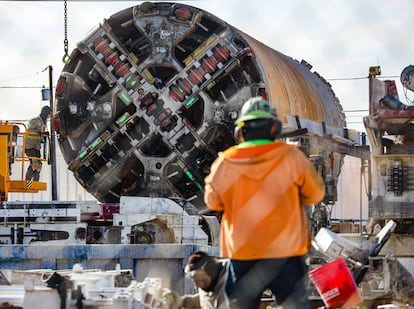
The stuff dreams are made of
The four local variants of The Loop project have made hardly any progress in the 15 months since CES 2023. The Chicago, Los Angeles and Baltimore projects appear to have gone into hibernation and there is little news about the Loop, with the exception of controversy in Las Vegas about worker complaints.
In the opinion of Walter Isaacson, the most prestigious of his biographers, Elon Musk is a genuine representative of the culture of the so-called “providential man” and of what could be defined as the syndrome of executive impatience. According to Isaacson, Musk tends to think that what he doesn’t do, no one else will, because contemporary capitalism suffers from a worrying shortage of disruptive leadership. He believes that the changes demanded by our societies are happening at an exasperatingly slow pace for lack of ambition, competence and, very often, financial muscle. And that everything he does not lead seems doomed to failure or, worse, to irrelevance.
Entrepreneurship expert Sid Mohasseb argues that Musk has become obsessed with gaining the superpowers of a James Bond movie villain. Boosted by a fortune that remains around $180 billion despite last year’s drop, the Pretoria-born tycoon “can manipulate entire markets with a single tweet,” says Mohasseb, or embark on cyclopean projects such as plans “to program minds” and take society’s elite on trips to outer space.
In 2022, Mohasseb warned of the self-proclaimed “technological savior’s” dominance in diverse fields, be it driving the electric revolution with Tesla, implanting microchips in human brains with Neuralink, conquering space and destroying the asteroids with SpaceX, providing new payment options with PayPal or guaranteeing the supply of Internet to the farthest corners of the planet with Starlink. And this was all before Musk set out to monopolize public debate through an “alternative” channel (Twitter, now X) or take artificial intelligence to another level with Grok.

Some of these projects may be considered “noble” and worthy of praise — more in line with the work of a philanthropist with an unprecedented fortune than of a Darth Vader or a Montgomery Burns — but Mohasseb points out that even the Joker “wanted to make the world smile.” He argues that it is not a good idea for all the eggs of technological disruption to be in the same basket and that, as Lord Acton once said, “absolute power corrupts absolutely.”
For Mohasseb, the recipe against this one-man monopoly of large transformative projects is not to clip Musk’s wings, but to create a breeding ground that promotes free competition much more strongly. As much as money attracts money, other entrepreneurs deserve the opportunity to enjoy the generous grants and strong corporate support that Musk has received since his name began to become synonymous with capitalism.
Other analysts have also supported the thesis that Musk is the supervillain of our time. Jim Lepore, from The New Yorker, argues that self-proclaimed superheroes slide down the slope of evil as soon as they begin to put their powers at the service of their own agenda, a switch that may have happened with Bill Gates. When Stephen Colbert invited Musk on his late night show, he asked him — with a heavy dose of irony — if he really wanted to save the world. And Liam Gaughan, from The Dallas Observer, goes so far as to compare him to Joffrey Baratheon from Game of Thrones, an autocrat who invites his subjects to speak out in order to identify the dissidents so he can purge them, as Mao Zedong did in his day.
Ultimately, as Alice Kelly argues in Your Tango, there are at least 16 “valid” reasons to hate Elon Musk, from how he has widened the global wealth, to his arrogant contempt for the diver who rescued a group of Thai schoolchildren, to his dalliances with the anti-vaccine movement, and to his treacherous manipulation of the cryptocurrency market. Seen this way, the fact that his plan to decongest traffic in Las Vegas has become stuck in a puddle of toxic mud with the consistency of milkshake doesn’t seem, by any stretch of the imagination, the worst of his actions.
Sign up for our weekly newsletter to get more English-language news coverage from EL PAÍS USA Edition
Tu suscripción se está usando en otro dispositivo
¿Quieres añadir otro usuario a tu suscripción?
Si continúas leyendo en este dispositivo, no se podrá leer en el otro.
FlechaTu suscripción se está usando en otro dispositivo y solo puedes acceder a EL PAÍS desde un dispositivo a la vez.
Si quieres compartir tu cuenta, cambia tu suscripción a la modalidad Premium, así podrás añadir otro usuario. Cada uno accederá con su propia cuenta de email, lo que os permitirá personalizar vuestra experiencia en EL PAÍS.
¿Tienes una suscripción de empresa? Accede aquí para contratar más cuentas.
En el caso de no saber quién está usando tu cuenta, te recomendamos cambiar tu contraseña aquí.
Si decides continuar compartiendo tu cuenta, este mensaje se mostrará en tu dispositivo y en el de la otra persona que está usando tu cuenta de forma indefinida, afectando a tu experiencia de lectura. Puedes consultar aquí los términos y condiciones de la suscripción digital.
More information
Archived In
Últimas noticias
Rowan Atkinson tops Netflix at 70: ‘He’s as funny as ever’
Israeli recognition of Somaliland stirs up the Gulf
Tiger Woods turns 50: Will he continue playing on the PGA Tour or take a back seat?
The surreal journey of James Nnaji, the Barcelona youth player selected in the NBA Draft who ended up in the NCAA
Most viewed
- Oona Chaplin: ‘I told James Cameron that I was living in a treehouse and starting a permaculture project with a friend’
- Reinhard Genzel, Nobel laureate in physics: ‘One-minute videos will never give you the truth’
- Sinaloa Cartel war is taking its toll on Los Chapitos
- Why the price of coffee has skyrocketed: from Brazilian plantations to specialty coffee houses
- Chevy Chase, the beloved comedian who was a monster off camera: ‘Not everyone hated him, just the people who’ve worked with him’

